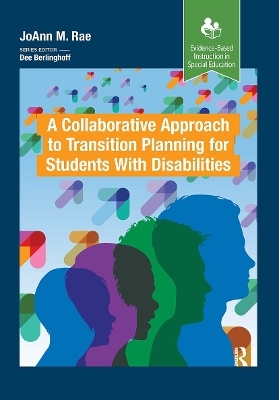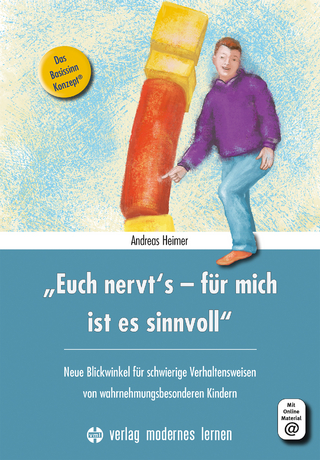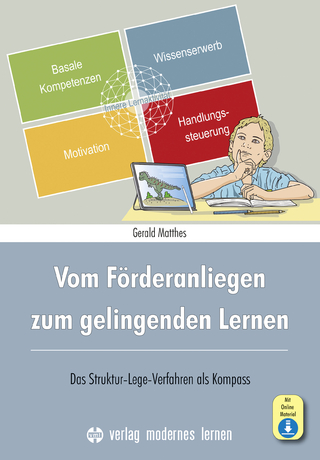
A Collaborative Approach to Transition Planning for Students with Disabilities
Routledge (Verlag)
978-1-032-95358-8 (ISBN)
- Noch nicht erschienen (ca. November 2024)
- Versandkostenfrei
- Auch auf Rechnung
- Artikel merken
A Collaborative Approach to Transition Planning for Students with Disabilities is designed to inform aspiring special education teachers, special education teams, transition planning specialists and school administrators about the complex process of transition planning and to meet the transition requirements of special education legislation.
Author Dr. JoAnn Rae has been in the field of special education for 34 years, in service as a special education teacher, special education administrator, teacher certification supervisor and as college faculty. The framework she outlines is specially designed to advance students’ involvement and participation in their lives, not only in the presence of the most severe sensory and intellectual disabilities, but also in the case of multiple disabilities. Unique scenarios not typically seen in other textbooks, such as IEP team disagreements, students with terminal illnesses, students with ill or overworked parents or students living in poverty are also explored.
The text also includes:
Descriptions of research-based practices to maximize students’ self-determination, autonomy, goal setting and ability to have successful life experiences
Opportunities to integrate knowledge with practice by providing strategies that relate to the real-life difficulties students and transition planning specialists may encounter
Easy-to-replicate communication tools, such as letters to students and parents, as examples to enhance collaboration
Methods for teachers to effectively promote and increase student involvement and collaboration by using structured and interactive interviews
A Collaborative Approach to Transition Planning for Students with Disabilities reflects the universal challenges that teachers, families and finally, the students themselves face, as they progress through school with a disability. For students with disabilities, the key component to successful transition planning is creating a collaborative atmosphere that allows them to be successful. This book promises to serve as an essential resource to all who are dedicated to that goal.
JoAnn M. Rae, EdD started her career as an educator when she earned a bachelor of science degree in special education and elementary education at West Chester University in West Chester, Pennsylvania. Later, Dr. Rae earned a master’s degree with distinction in educational administration, and she became certified as a general education principal and special education supervisor. As a master’s student, she was nominated to Who’s Who Among Students in American Universities and Colleges in recognition of merit and accomplishment. Throughout 18 years of direct teaching experience, Dr. Rae worked with students throughout the transition planning process. As a transition planning specialist using legislative guidelines and research-based practices, she worked with students, their families, and school districts using a collaborative approach to transition planning. Dr. Rae earned a doctorate with distinction in education, specializing in special education. Her studies and dissertation reported on effective practices that have the potential to lead to positive post-school outcomes for students with disabilities. As she earned her doctorate, Dr. Rae was a special education administrator for 7 years, prior to moving to university teaching. In the special education supervisor role, she monitored transition plans and the implementation of transition strategies through the work of the special educators in her department. In this role, Dr. Rae worked with school district officials, families, and community agencies to facilitate smooth transitions to post-school life. Currently, Dr. Rae teaches graduate school courses in the Department of Special Education at St. Joseph’s University, Graduate Division, in Philadelphia, Pennsylvania. She also teaches courses on the administration of special education programs. Dr. Rae’s work reflects her expertise in collaborating within school communities to develop effective transition plans grounded in research-based practices. Dr. Rae’s education and practical experience working directly with students, their families, school personnel, and district administrators makes her uniquely qualified to write this text.
Dedication Acknowledgments About the Author Preface Introduction Part 1 Introduction to Transition Planning Chapter 1 Transition Planning and Special Education Law Part 2 Transition Planning Practices Chapter 2 An Interactive Framework of Activities Focusing on Community Access,Student Engagement, and Post-School Goals Selection Chapter 3 Collaborating With Families During the Transition Planning Process Part 3 Assessments Chapter 4 Medical Conditions, Assessment, and Transition: Implications of Disability and Medical Conditions on Work-Seeking Activities andEducational Progress Chapter 5 Assessment Tools Part 4 Transition Plan Development Chapter 6 Transition Plan Frameworks: Creating the Transition Plan Chapter 7 Career and Employment-Based Learning:Supporting Entry Into the Workforce and Postsecondary Education Part 5Special Education Programs: Responsibilities and Resourcesof Transition Team Members and Community andGovernmental Agencies Chapter 8 School Leadership and Transition Planning Chapter 9 Roles of the Secondary Special EducationTeam and Community Agencies Part 6 Special Considerations: Working With Diverse Groups of Students Chapter 10 Students With Specific LearningDisabilities and Speech and Language Impairments Chapter 11 Students With Emotional, Behavioral, and SevereMental Health Disorders Chapter 12 Students Who Are Blind, VisuallyImpaired, Deaf, Hard of Hearing, or Deaf-Blind Section 1: Students Who Are Blind or Visually Impaired Section 2: Students Who Are Deaf, Hard of Hearing, or Deaf-Blind Chapter 13 Students With Autism Without Accompanying Language orIntellectual Impairment Chapter 14 Students With Other Health Impairments, Chronic Medical andOrthopedic Impairments, and Traumatic Brain Injury Chapter 15 Students With Mild, Moderate, Severe, Multiple, and ProfoundIntellectual Disabilities Chapter 16 Students With Autism and Accompanying Language andIntellectual Impairment Part 7 Special Education Transitions Chapter 17 The Effectiveness of Transition Planning: Monitoring the Practices of theSpecial Education Team Chapter 18 Special Education Transitions From Birth to Age 21 Glossary Index
| Erscheint lt. Verlag | 4.11.2024 |
|---|---|
| Reihe/Serie | Evidence-Based Instruction in Special Education |
| Verlagsort | London |
| Sprache | englisch |
| Maße | 178 x 254 mm |
| Gewicht | 980 g |
| Themenwelt | Sozialwissenschaften ► Pädagogik ► Sonder-, Heil- und Förderpädagogik |
| ISBN-10 | 1-032-95358-6 / 1032953586 |
| ISBN-13 | 978-1-032-95358-8 / 9781032953588 |
| Zustand | Neuware |
| Haben Sie eine Frage zum Produkt? |
aus dem Bereich


